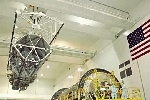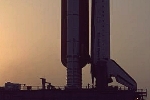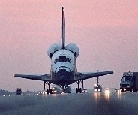- text as of last publication -
![]() Operations
Operations
------------
LAST! ... MISSION OVER! ...
The Space Shuttle successfully landed like planned at the Shuttle Landing Facility of the KSC, Fla. Touchdown was at 6:21 a.m. EDT on Thursday, September 21st, on runway 33. It was a night landing. The de-orbit burn occurred at 5:14 a.m. All times were according to the schedule. A debris question postponed the landing by one day as they were finally deemed tolerable by NASA which cleared the Shuttle for a landing. The Space Shuttle had undocked from the ISS last Sunday, at 8:50 a.m. EDT. The Shuttle has been towed back to the Orbiter Processing Facility. The STS-115 mission resumed the construction work at the outpost, installing -through 3 spacewalks- a new truss with solar arrays, which will increase the power available to the ISS. see our comprehensive tutorial on how a Space Shuttle is coming back Earth
. see more:
. see our mission's gallery below!
. the mission's timeline
The STS-115 mission, after an usual two-day flight readiness review at the Kennedy Space Center, was decided for a launch date, from which any subsequent modification started. The launch countdown usually is beginning at T-43 hours. It will be performed by the launch team from the newly renovated firing room 4 of the Launch Control Center in the Kennedy Space Center (KSC). The countdown includes 27 hours and 24 minutes of built-in holds. The mission is to last 11 days
A live countdown coverage from NASA's Launch Blog and NASA TV is usually performed on the launch day. Check at the NASA site
last updated: Sep. 26th, 2006
------------
The STS-115 mission means the Space Shuttle back to the construction of the ISS. Such a construction had been interrupted since February 2003 due to the dramatic loss of shuttle Columbia. The STS-115 mission is carrying up there the P3/P4 truss segment, being the next major addition to the 11-segment integrated truss structure that will eventually span more than 300 feet on the station. The truss, with its two large solar arrays, will provide one-fourth of the total power-generation capability of the completed station
The International Space Station (ISS) is originally a 16 nations partnership (USA, Canada, 11 countries from the European Union, Japan, Russia, Brazil). Beginning November 1998, 40 flights were forecasted for the completion of the orbital outpost. 20 flights have alreday been performed. The ISS will now mostly be used like an orbiting laboratory where the aptitude of space crews to long-duration spaceflights will be tested in prevision of the future missions to Mars. more about the ISS
![]() PLUS RECENT! ... MISSION TERMINEE! ... La navette spatiale a atterri avec succès jeudi 21 septembre à 11h 21 GMT sur la piste 33 du Shuttle Landing Facility du Kennedy Space Center, en Floride. Cela a été un atterrissage de nuit. La mise à feu pour quitter l'orbite a eu lieu à 10h 14. Toutes les opérations se sont déroulées exactement dans les temps prévus. La question d'un ou de débris vus autour de la navette a retardé l'atterrissage d'un jour mais la navette a jugé que lesdits débris étaient dans les limites admises et elle autorisé l'atterrissage. La navette s'était désarrimée dimanche à 13h 50 GMT de l'ISS. La navette a été tractée jusqu'à l'"Orbiter Processing Facility", ce lieu du Kennedy Space Center où les navettes sont préparées pour les missions suivantes. La mission STS-115 a repris la construction de la Station Spatiale Internationale, ajoutant -en 3 sorties dans l'espace- une nouvelle poutre et des panneaux solaires, qui vont accroître l'énergie disponible pour la Station. pour les personnes lisant l'anglais, nous avons un tutoriel sur comment une navette spatiale revient sur Terre
PLUS RECENT! ... MISSION TERMINEE! ... La navette spatiale a atterri avec succès jeudi 21 septembre à 11h 21 GMT sur la piste 33 du Shuttle Landing Facility du Kennedy Space Center, en Floride. Cela a été un atterrissage de nuit. La mise à feu pour quitter l'orbite a eu lieu à 10h 14. Toutes les opérations se sont déroulées exactement dans les temps prévus. La question d'un ou de débris vus autour de la navette a retardé l'atterrissage d'un jour mais la navette a jugé que lesdits débris étaient dans les limites admises et elle autorisé l'atterrissage. La navette s'était désarrimée dimanche à 13h 50 GMT de l'ISS. La navette a été tractée jusqu'à l'"Orbiter Processing Facility", ce lieu du Kennedy Space Center où les navettes sont préparées pour les missions suivantes. La mission STS-115 a repris la construction de la Station Spatiale Internationale, ajoutant -en 3 sorties dans l'espace- une nouvelle poutre et des panneaux solaires, qui vont accroître l'énergie disponible pour la Station. pour les personnes lisant l'anglais, nous avons un tutoriel sur comment une navette spatiale revient sur Terre
voir ci-dessous (en anglais seulement):
. notre galerie de la mission
. la chronologie de la mission
Après la classique revue de préparation de deux jours, la mission STS-115 de la navette spatiale a été autorisée au décollage à une certaine date, date à partir de laquelle ont eu lieu les possibles modifications dûs aux évènements. Le compte à rebours commence habituellement 43 heures avant le lancement. Le compte à rebours est assuré par l'équipe de lancement depuis la salle 4, récemment rénovée, du Centre de Contrôle de Lancement ("Launch Control Center") du Kennedy Space Center. Le compte à rebours comprend 27h et 24 mn de périodes d'arrêt diverses. La mission durera 11 jours
Une couverture en direct du lancement par le système des "blogs de lancement" ("Launch Blog") et la TV de la NASA est habituellement assurée le jour du lancement. Voir (en anglais seulement) sur le site de la NASA
dernière mise à jour: 26/09/2006
------------
La mission STS-115 de la navette spatiale est le retour de la navette à la construction de la Station Spatiale Internationale. Celle-ci avait été interrompue depuis la perte de la navette Columbia en février 2003. La mission STS-115 emporte à la Station Spatiale Internationale le segment P3/P4, qui porte, de plus, deux panneaux solaires qui fourniront un quart de l'énergie de la Station
La Station Spatiale Internationale est, originellement, un projet en collaboration de 16 nations (Etats-Unis, Canada, 11 pays de l'Union Européenne, Japon, Russie, Brésil). La construction a commencé en novembre 1998 et 40 vols de construction -dont 20 déjà accomplis- sont prévus. La Station Spatiale Internationale va maintenant être essentiellement utilisée pour tester l'aptitude des équipages aux vols spatiaux de longue durée, dans le but des vols vers Mars. plus sur la Station Spatiale Internationale
![]() Operations Gallery
Operations Gallery
(none of these pictures are thumbnails; the gallery is in this format only)
 |  | click to the entire gallery | ||
| The ISS Port 3/4 truss loaded into its payload canister. picture NASA/Troy Crider | Shuttle Discovery moved to launch pad 39B, Aug. 2. picture NASA/George Shelton | |||
.see a simplified mission's timeline
STS-115 - 19th ISS Flight (12A)-P3/P4 Solar Arrays
(the mission about the third port truss segment -crew: Polansky, Oefelein, Curbeam, Joan Higginbotham, Nicholas Patrick, Fuglesang, an ESA astronaut- seems to have been replaced by this one)
see our fine page about the construction stages of the ISS. It's part of our section dedicated to the ISS
| What's going on after liftoff? Check this sequence of the events! | |
| T-6.5 sec | the 3 main engines ignite |
| T-0 | the two Solid Rocket Boosters (SRBs) ignite; the Shuttle is released |
| Into the flight | the main engines are throttled back to reduce aerodynamics load ("Q") due to the thick lower atmosphere. Engines are throttled up back when the atmosphere becomes thinner |
| T+2:00 mn | SRBs burn out. Throttle back again to ease the SRBs being jettisoned. Small rockets help to disconnect them, and push them away, from the shuttle and the External Tank. The main engines alone continue to push (the acceleration reaches its maximum of 3 G), as the throttle is controlled to reduce stress on the shuttle's structure and passengers |
| T+8:30 | main engines shut down (Main Engine Cutoff, MECO), the External Tank is jettisoned. The shuttle is short of orbital speed. This is done to ensure that the tank doesn't go orbital but falls back instead and burns into the atmosphere |
| MECO+45 | after 45 mn coasting, the shuttle fires two small Orbital Maneuvering System engines, which are giving the final nudge to orbit. The shuttle is now orbiting! |
![]() What in Case of An Aborted Launch?
What in Case of An Aborted Launch?
 |
| the Shuttle landed. picture NASA |
 |
| launch pad 39B, KSC. picture NASA |
->for more, see the official Shuttle page at NASA
Website Manager: G. Guichard, site 'Amateur Astronomy,' http://stars5.6te.net. Page Editor: G. Guichard. last edited: 12/28/2010. contact us at ggwebsites@outlook.com